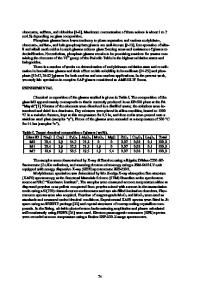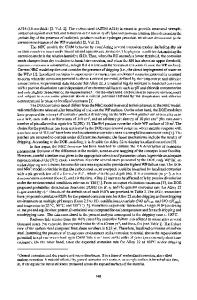Increased Molybdenum Loading for Vitrified High Level Waste
- PDF / 279,156 Bytes
- 7 Pages / 432 x 648 pts Page_size
- 61 Downloads / 291 Views
Increased Molybdenum Loading for Vitrified High Level Waste Nick R. Gribble1, Rick J Short1, Barbara F. Dunnett1 and Carl J. Steele2 1 National Nuclear Laboratory, Sellafield, Seascale, Cumbria, UK, CA20 1PG 2 Sellafield Ltd, Sellafield, Seascale, Cumbria, UK, CA20 1PG ABSTRACT The solubility of molybdenum in borosilicate glasses is low. The UK National Nuclear Laboratory has developed a new glass formulation containing calcium and zinc for the vitrification of high molybdenum containing waste arising from the Post Operational Clean Out of the Highly Active Storage Tanks at Sellafield that will decrease the number of product containers required, reducing both production and disposal costs. The new formulation increases the quantity of molybdenum that can be vitrified through the formation of a durable CaMoO4 phase once the solubility limit of molybdenum in the glass has been exceeded. Extensive laboratory trials confirmed the potential to increase the Mo loading significantly. Recently full scale testing has been performed on the Vitrification Test Rig using highly active liquor simulants to determine the maximum MoO3 loading that can be achieved. This paper explores the full scale testing and product quality of the glass manufactured during this study. INTRODUCTION The Highly Active Liquor (HAL) stored in the Highly Active Storage Tanks (HASTs) at Sellafield contains a quantity of solids. The major solid phases that precipitate or crystallise within HAL are barium-strontium nitrate, zirconium molybdate (ZM) and caesium phosphomolybdate (CPM), but it is expected that under the current HASTs conditions most of the CPM will have converted to ZM. Zirconium phosphates are also present as a solid phase, but only a small proportion will have settled to the base of the tanks due to its flocculent nature. Prior to decommissioning, the Post Operational Clean Out (POCO) of the HASTs will result in waste streams with relatively high molybdenum contents. It is likely that these POCO wastes will be blended with typical THORP and Magnox reprocessing wastes prior to vitrification. The standard alkali borosilicate base glass crizzle (MW – “Mixture Windscale”) used for the immobilisation of High Level Waste (HLW) streams within the Sellafield Waste Vitrification Plant (WVP) can tolerate some Mo, but at concentrations >5.25 wt% MoO3 phase separation becomes readily apparent. The yellow phase formed is a mixture of alkali, alkaline earth and rare earth molybdates and chromates, is undesirable in the vitrified product as it is partially water soluble and is corrosive to the Nicrofer melting crucible. The number of product containers required for vitrification of POCO waste will be dependent on the incorporation of MoO3 into the glass. Hence, a new glass formulation shown in Table I containing calcium and zinc, known as ‘Ca/Zn’ has been developed for the vitrification of high molybdenum waste. The Ca/Zn formulation increases the quantity of molybdenum that can be vitrified through the formation of a durable CaMoO4 phase once the solubil
Data Loading...











